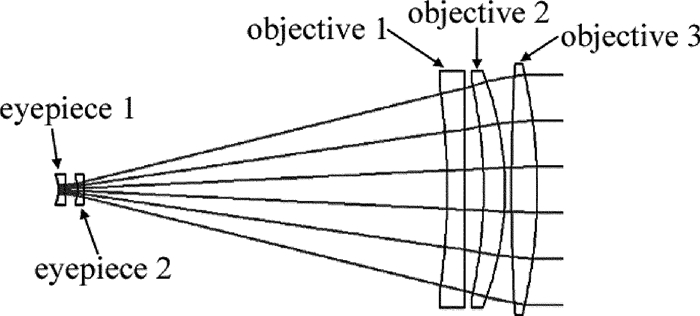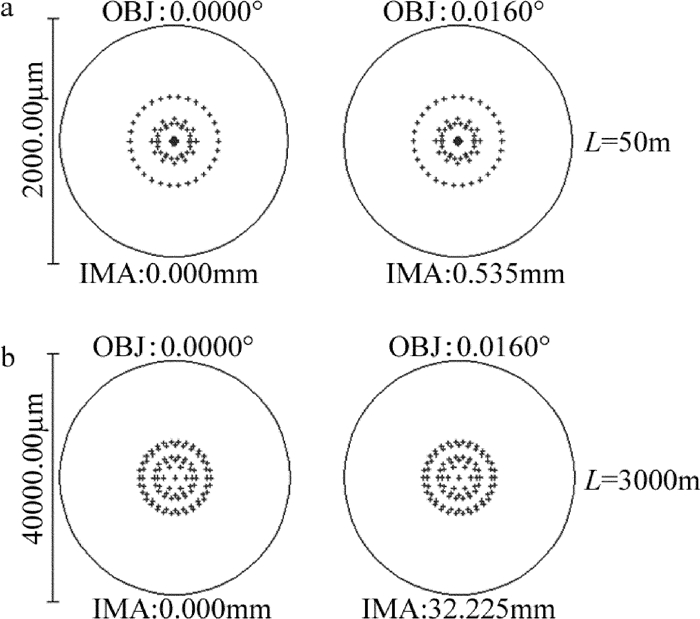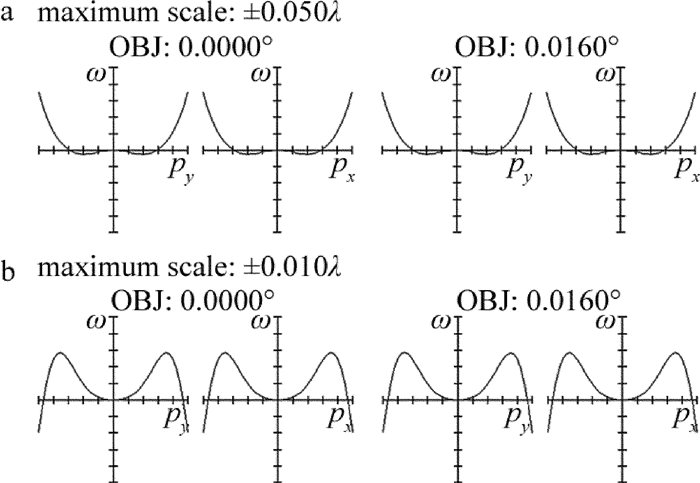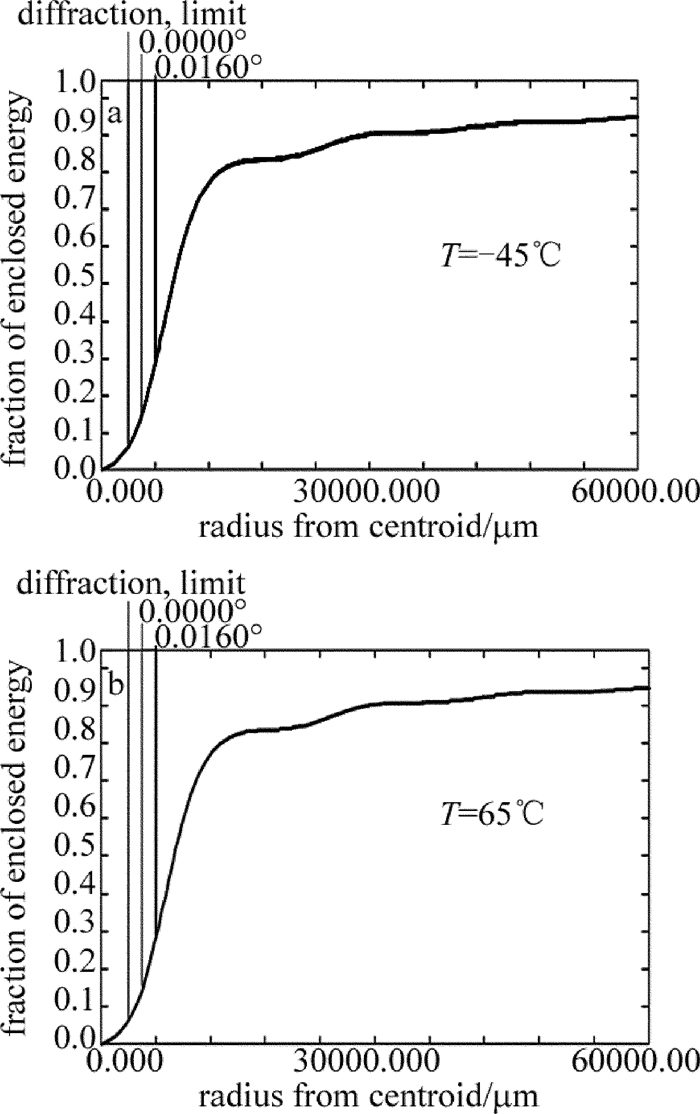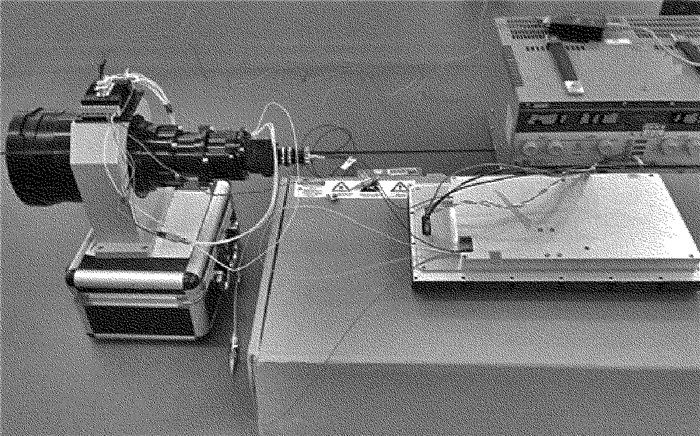Design of refractive antennas with coaxial transceiver for wind lidars
-
摘要: 为了提高光学系统的环境适应性,采用光机结合被动消热差的方法,设计消热差的折射式收发同轴光学天线。利用ZEMAX软件仿真分析了工作距离为50m~3000m、环境温度为-45℃~65℃范围内所设计天线的像质情况;搭建实验平台,测试实际光斑质量,并对仿真结果进行了实验验证。结果表明,天线在探测范围内波像差小于0.25λ,光学质量接近衍射极限,在环境温度变化范围内光斑90%的能量集中在最大相干长度内,且各视场能量分布均匀。该研究为天线的光学参量和结构参量合理化设计提供了理论依据。Abstract: To improve environmental adaptability of an optical system, an athermalization refractive antenna with coaxial transceiver was designed by the passive athermalization method combined with the optics and machinery. By using ZEMAX software, the image quality of the designed antenna was simulated and analyzed when the working distance ranged from 50m to 3000m and the environment temperature ranged from -45℃ to 65℃. After building experimental platform and measuring the actual image quality, the simulation results were verified. The results show that the optical path difference is less than 0.25λ and the optical quality of the designed antenna is close to the diffraction limit within the detection range. Moreover, within the scope of environmental temperature, the energy of the 90% of the spots is concentrated in the maximum coherence length. And the spot energy distribution of each field is uniform. The research can provide the theoretical basis for the design of the optical parameters and structure parameters of the antenna.
-
Keywords:
- optical design /
- wind lidar /
- refractive antenna /
- coaxial transceiver /
- athermalization
-
-
Table 1 Parameters of optical antenna
No. radius/mm thickness/mm glass 1 -15.50 3 H-ZF10 2 35.33 6 3 -13.24 3 H-ZF10 4 -65.55 169 5 -297.50 8 F_SILICA 6 infinity 9 7 -203.20 10 H-ZF10 8 -129.60 3 STO 852.30 12 H-ZF10 10 -214.90 Table 2 Spot diameters under different temperatures (L=50m)
20℃ -45℃ 65℃ simulation/mm 1.72 2.68 1.80 measurement/mm 1.96 2.76 2.04 Table 3 Spot diameters at different temperatures (L=3000m)
20℃ -45℃ 65℃ simulation/mm 0.25 0.33 0.252 measurement/mm 0.32 0.44 0.324 -
[1] TAWFIK T M. Efficient approach to designing a Schmidt-Cassegrain objective for a remote sensing satellite[J]. Applied Optics, 2009, 48(35):6832-6840. DOI: 10.1364/AO.48.006832
[2] LU Q, SHEN W M, PAN J Y, et al. Design of a coaxial microwave/IR dual mode antenna[J]. Infrared and Laser Engineering, 2011, 40(11):2229-2232(in Chinese). http://www.wanfangdata.com.cn/details/detail.do?_type=perio&id=hwyjggc201111031
[3] CHENG Y Y. Research on space laser communication optical system[D]. Xi'an: Xi'an Insititute of Optics and Precission Mechanics Chinese Academy of Science, 2012: 16-21(in Chinese).
[4] LIU F, WANG J, DING J, et al. Optical receiving antenna based on movable transmitting antenna[J]. Journal of Applied Optics, 2013, 34(1):32-37(in Chinese). http://www.wanfangdata.com.cn/details/detail.do?_type=perio&id=yygx201301006
[5] DAVID L S. Geometric optics-based design of laser beam[J]. Optical Engineering, 2003, 42(11):3123-3128. DOI: 10.1117/1.1617311
[6] LI L. Design of infrared dual-band a thermal optical system[D]. Nanjing: Nanjing University of Aeronautics and Astronautics, 2012: 13-17(in Chinese).
[7] DAVID B. Scalable MW IR and LW IR optical system designs employing a large spherical primary mirror and small refractive aberration correctors[J]. Proceedings of the SPIE, 2001, 4441:154-162. DOI: 10.1117/12.449561
[8] GREISUKH G I, EZHOV E G, STEPANOV S A. Aberration properties and performance of a new diffractive-gradient-index high resolution-objective[J]. Applied Optics, 2001, 40(16):2730-2735. DOI: 10.1364/AO.40.002730
[9] MAREK Z, JERZY N. Correction of chromatic aberration in hybrid objectives[J]. Optik, 2002, 113(7):299-302. DOI: 10.1078/0030-4026-00172
[10] WANG H J, WANG W, WANG X, et al. Space camera image degradation induced by satellite micro-vibration[J]. Acta Photonica Sinica, 2013, 42(10):1212-1217(in Chinese). DOI: 10.3788/gzxb
[11] JIANG K, ZHOU S Z, LI G, et al. Athermalization design of catadioptric middle infrared dual field zoom system[J]. Infrared and Laser Engineering, 2013, 42(2):403-407(in Chinese). http://www.wanfangdata.com.cn/details/detail.do?_type=perio&id=hwyjggc201302024
[12] LAN G P, WANG X, LIANG W, et al. Optical design and thermal analysis for the active-focusing aerial camera objective[J]. Acta Optica Sinica, 2012, 32(3):322006(in Chinese). DOI: 10.3788/AOS
[13] ZHANG X, JIA H G, ZHANG Y. Optical design of athermalized infrared telephoto objective[J]. Infrared and Laser Engineering, 2012, 41(1):178-183(in Chinese). http://en.cnki.com.cn/Article_en/CJFDTOTAL-HWYJ201201034.htm
[14] TANG T J. Optical system design of light star tracker with low F-number[J]. Spacecraft Recovery & Remote Sensing, 2011, 32(3):36-42(in Chinese). http://www.wanfangdata.com.cn/details/detail.do?_type=perio&id=htfhyyg201103006
[15] YAN A Q, YANG J F, CAO J Z. Optical design of aerial digital camera based on large planar array CCD[J]. Acta Optica Sinica, 2011, 31(6):0622003(in Chinese). DOI: 10.3788/AOS
[16] FENG L K. Optical antenna characteristic analysis and design of 2μm coherent wind LIDAR[D]. Harbin: Harbin Institute of Technology, 2012: 33-44(in Chinese).
[17] LIU B, TAO W, KE Z G, et al. Balance coherent detection technology of coherent lidar[J]. Laser Technology, 2015, 39(1):46-49(in Chinese). http://www.wanfangdata.com.cn/details/detail.do?_type=perio&id=jgjs201501009
[18] GUO S Y, HU X, YAN Z A, et al. Research development of space-borne lidar in foreign countries[J]. Laser Technology, 2016, 40(5):772-778(in Chinese). http://www.wanfangdata.com.cn/details/detail.do?_type=perio&id=jgjs201605032
[19] ZHANG F Q, FAN X, KONG H, et al. Influence of temperature on infrared optical system and a thermal design[J]. Laser & Infrared, 2015, 45(7):854-860(in Chinese). http://www.wanfangdata.com.cn/details/detail.do?_type=perio&id=9d190665be8d9c6458e162f1775b9c26
-
期刊类型引用(0)
其他类型引用(3)




 下载:
下载:
